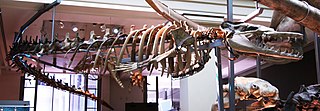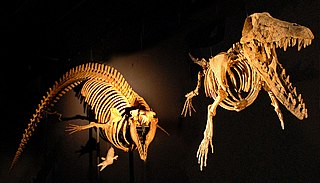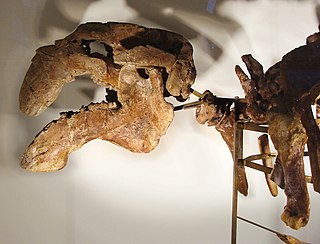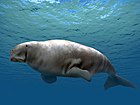
Rodhocetus is an extinct genus of protocetid early whale known from the Lutetian of Pakistan. The best-known protocetid, Rodhocetus is known from two partial skeletons that taken together give a complete image of an Eocene whale that had short limbs with long hands and feet that were probably webbed and a sacrum that was immobile with four partially fused sacral vertebrae. It is one of several extinct whale genera that possess land mammal characteristics, thus demonstrating the evolutionary transition from land to sea.

Basilosaurus is a genus of large, predatory, prehistoric archaeocete whale from the late Eocene, approximately 41.3 to 33.9 million years ago (mya). First described in 1834, it was the first archaeocete and prehistoric whale known to science. Fossils attributed to the type species B. cetoides were discovered in the United States. They were originally thought to be of a giant reptile, hence the suffix "-saurus", Ancient Greek for "lizard". The animal was later found to be an early marine mammal, prompting attempts at renaming the creature, which failed as the rules of zoological nomenclature dictate using the original name given. Fossils were later found of the second species, B. isis, in 1904 in Egypt, Western Sahara, Morocco, Jordan, Tunisia, and Pakistan. Fossils have also been unearthed in the southeastern United States and Peru.

Archaeoceti, or Zeuglodontes in older literature, is a paraphyletic group of primitive cetaceans that lived from the Early Eocene to the late Oligocene. Representing the earliest cetacean radiation, they include the initial amphibious stages in cetacean evolution, thus are the ancestors of both modern cetacean suborders, Mysticeti and Odontoceti. This initial diversification occurred in the shallow waters that separated India and Asia 53 to 45 mya, resulting in some 30 species adapted to a fully oceanic life. Echolocation and filter-feeding evolved during a second radiation 36 to 35 mya.

Protocetus atavus is an extinct species of primitive cetacean from Egypt. It lived during the middle Eocene period 45 million years ago. The first discovered protocetid, Protocetus atavus was described by Fraas 1904 based on a cranium and a number of associated vertebrae and ribs found in middle Lutetian Tethyan marine limestone from Gebel Mokattam near Cairo, Egypt.

Kutchicetus is an extinct genus of early whale of the family Remingtonocetidae that lived during Early-Middle Eocene in what is now the coastal border of Pakistan and India. It is closely related to Andrewsiphius with which it was synonymized by Gingerich et al. 2001. Thewissen & Bajpai 2009 proposed a new clade, Andrewsiphiinae, for the two species. Later authors, however, still accept both as separate genera.

Remingtonocetus is an extinct genus of early cetacean freshwater aquatic mammals of the family Remingtonocetidae endemic to the coastline of the ancient Tethys Ocean during the Eocene. It was named after naturalist Remington Kellogg.

Eotheroides is an extinct genus of Eocene sirenian. It is an early member of the family Dugongidae, which includes the extant dugong. Fossils have been found from Egypt, India, and Madagascar. Eotheroides was first described by Richard Owen in 1875 under the name Eotherium, which was replaced by the current name in 1899.

Remingtonocetidae is a diverse family of early aquatic mammals of the order Cetacea. The family is named after paleocetologist Remington Kellogg.

Dalanistes is an extinct genus of remingtonocetid early whale known from the late-early Eocene of Kutch, India and Punjab and Balochistan, Pakistan. Dalanistes is closely related to Remingtonocetus, but also shares several features with Ambulocetus, and, with its combination of terrestrial and amphibious adaptations, Dalanistes apparently is an intermediate form between these two groups. Isotopic evidence suggest that Dalanistes had a marine diet.
Gaviacetus is an extinct archaeocete whale that lived approximately 45 million years ago. Gaviacetus was named for its characteristic narrow rostrum and the fast pursuit predation suggested by its unfused sacral vertebrae.
Basiloterus is an extinct genus of late-Eocene archaeocete whale from the Drazinda Formation in southwestern Punjab, Pakistan and possibly also the Barton Group of England. Known from two isolated lumbar vertebrae, the elongated nature of these elements has been taken as possible evidence that Basiloterus was a close relative of the better-known Basilosaurus. This was also the reasoning behind its name, which roughly translates to "another king". However, publications since then not only lead to some major changes of the internal relationships within Basilosauridae but have also called into question how diagnostic elongated vertebrae are for members of this group, as other early whales have developed similar anatomy independently. Though the identity of Basiloterus as a basilosaurid is generally maintained, its exact position within more recent interpretations of the family is unclear.
Protocetidae, the protocetids, form a diverse and heterogeneous group of extinct cetaceans known from Asia, Europe, Africa, South America, and North America.
Protosiren eothene is a species of Lutetian sirenian, found in the upper part of the Habib Rahi Formation, Pakistan.
Babiacetus is an extinct genus of early cetacean that lived during the late Lutetian middle Eocene of India . It was named after its type locality, the Harudi Formation in the Babia Hills, Kutch District, Gujarat, India.
Makaracetus is an extinct protocetid whale, the remains of which were found in 2004 in Lutetian layers of the Domanda Formation in the Sulaiman Range of Balochistan, Pakistan.

Eosiren is an extinct genus of sea cow that lived during the Late Eocene to Early Oligocene (Rupelian). Several fossils have been found in Egypt. It seems like the species E. abeli were contemporaneous with Protosiren and Eotheroides. like them, Eosiren closely resembled modern sirenians. It differs from them by having somewhat larger innominates and possess thigh bones.

Qaisracetus is an extinct protocetid early whale known from the Eocene of Baluchistan, Pakistan.
Carolinacetus is an extinct protocetid early whale found in the Bartonian Tupelo Bay Formation in Berkeley County, South Carolina.

Indocetus is a protocetid early whale known from the late early Eocene Harudi Formation in Kutch, India.
Eocetus is an extinct protocetid early whale known from the early-late Eocene Giushi Formation in Gebel Mokattam, outside Cairo, Egypt. Fossil remains have also been discovered in the Aridal Formation of the Sahara Desert in southwestern Morocco.














